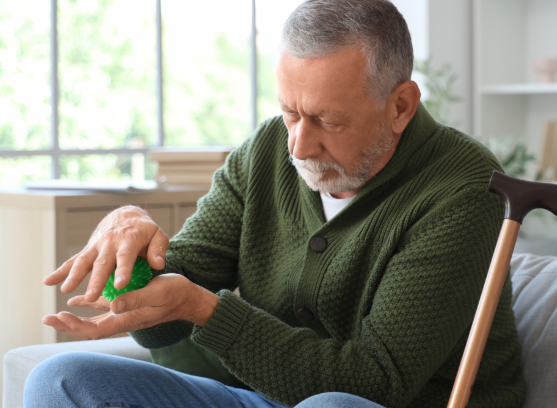Understanding Parkinson’s Disease: A Guide for Patients and Families
Understanding Parkinson’s Disease: A Guide for Patients and Families

What Is Parkinson’s Disease?
Parkinson’s disease is a long-term (chronic) disorder of the nervous system that mainly affects movement. It occurs when nerve cells in a part of the brain called the substantia nigra gradually stop producing enough dopamine, a chemical messenger that helps coordinate movement. As these cells diminish—often by 60 to 80 percent—movement symptoms start to appear.
Common Signs and Symptoms
Parkinson’s symptoms develop slowly over time and usually begin on one side of the body. Here are the classic signs:
- Tremor: Shaking or trembling in the hand, arm, leg, jaw, or even the head.
- Bradykinesia: Slowness in starting or carrying out movement, like walking or standing up.
- Rigidity: Stiffness in the limbs or torso that can be painful and limit movement.
- Postural Instability: Impaired balance and coordination, making falls more likely.
But Parkinson’s isn't just about movement—many patients also experience:
- Non-motor symptoms: These can include constipation, sleep troubles, a decreased sense of smell, dizziness, and changes in mood or memory.
- Bone and fall risk: People with Parkinson’s have a higher chance of fractures—especially hip breaks—often tied to both falls and lower bone density.
What Causes It?
While the exact cause of Parkinson’s isn't known, research suggests a mix of:
- Genetic factors: In some cases, Parkinson’s is inherited, but most cases aren’t clearly passed down in families.
- Environmental contributors: Things like pesticide exposure and industrial chemicals may affect risk.
- Inside the brain, the buildup of abnormal proteins (like alpha-synuclein forming Lewy bodies) and inflammation contribute to nerve cell damage.
How Is Parkinson’s Diagnosed?
There is no single lab test for Parkinson’s. Instead, diagnosis typically involves:
- A detailed medical history and neurological exam.
- Observation of symptoms.
- Assessing response to Parkinson’s medications—improvement after treatment can support the diagnosis.
Other conditions may mimic Parkinson’s (called Parkinsonism), so accurate testing and evaluation are key.
Treatments: Managing Symptoms, Improving Quality of Life
Though there’s no cure yet, various treatments can ease symptoms and support day-to-day living.
Medication
- Levodopa (often paired with carbidopa) remains the mainstay treatment—it helps the brain make more dopamine.
- Other options include dopamine agonists, MAO-B inhibitors, COMT inhibitors, amantadine, and anticholinergics—each targeting symptoms in different ways.
- Some of these aim to help movement, while others address stiffness or tremor.
Surgery: Deep Brain Stimulation (DBS)
For patients who don’t respond well to medicines, DBS may be an option. It involves implanting electrodes in the brain that help control symptoms such as tremors and rigidity.
Therapies & Lifestyle Support
- Physical, occupational, and speech therapy can improve movement, swallowing, speech, and daily function.
- Regular exercise—such as strength training, balance work, walking, or even tai chi and yoga—enhances mobility and may slow the progression of symptoms.
- Speech therapy (like LSVT) helps with voice clarity; occupational therapy helps maintain independence.
- Diet: A high-fiber, balanced diet can reduce constipation and support digestion. Timing protein away from levodopa helps the medicine work better.
- Support networks: Joining support groups can offer practical advice and emotional help for both patients and families.
What About Research and the Future?
The search continues for neuroprotective treatments that might slow or stop disease progression. Research is exploring:
- Experimental drugs
- Gene therapy
- Stem cell approaches
Vaccines and immunotherapies - Ways to detect the disease earlier—before symptoms show
While nothing is proven yet, staying informed about these developments offers hope.
Living with Parkinson’s: What You Can Do
- Stay active: Physical movement helps both your body and mind.
- Partner with specialists: Neurologists and therapy teams tailor care to your journey.
- Healthy diet: Eat well, stay hydrated, and ensure fiber intake.
- Build a support system: Lean on community, friends, family, and groups as challenges arise.
- Stay informed: Ask about new therapies, clinical trials, or wearable tools that may help.
Why Choose BNL Health for Parkinson’s Care?
At BNL Health — Brain, Neuro & Life, our physicians trained in complex neurological conditions, have expertise in diagnosing and managing neurodegenerative diseases like Parkinson’s. At our Movement Disorders clinic, we stay current with the latest therapies and offer comprehensive, compassionate care tailored to each patient’s needs.
In Summary
Parkinson’s disease is a complex, chronic condition that affects movement—and often other parts of daily life too. While there's no cure yet, effective treatments, therapies, lifestyle changes, and emotional support can make a real difference. Early diagnosis and individualized care help people live well and maintain their independence.
Take the Next Step with BNL Health
If you or a loved one is facing symptoms like tremor, stiffness, slowed movement, or balance problems, don’t wait.
Contact BNL Health today to schedule a consultation and explore how we can help you navigate Parkinson’s with expert care and support.


